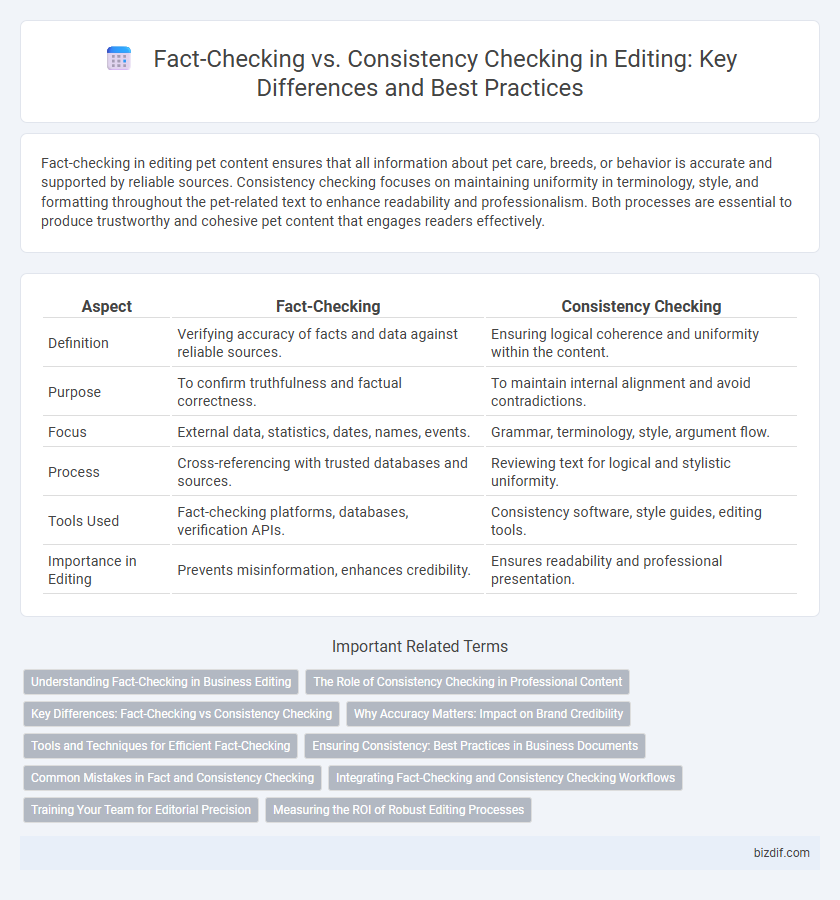Fact-checking in editing pet content ensures that all information about pet care, breeds, or behavior is accurate and supported by reliable sources. Consistency checking focuses on maintaining uniformity in terminology, style, and formatting throughout the pet-related text to enhance readability and professionalism. Both processes are essential to produce trustworthy and cohesive pet content that engages readers effectively.
Table of Comparison
| Aspect | Fact-Checking | Consistency Checking |
|---|---|---|
| Definition | Verifying accuracy of facts and data against reliable sources. | Ensuring logical coherence and uniformity within the content. |
| Purpose | To confirm truthfulness and factual correctness. | To maintain internal alignment and avoid contradictions. |
| Focus | External data, statistics, dates, names, events. | Grammar, terminology, style, argument flow. |
| Process | Cross-referencing with trusted databases and sources. | Reviewing text for logical and stylistic uniformity. |
| Tools Used | Fact-checking platforms, databases, verification APIs. | Consistency software, style guides, editing tools. |
| Importance in Editing | Prevents misinformation, enhances credibility. | Ensures readability and professional presentation. |
Understanding Fact-Checking in Business Editing
Fact-checking in business editing involves verifying data, statistics, and claims within corporate documents to ensure accuracy and reliability. This process reduces misinformation risk and builds trust with stakeholders by confirming sources and validating facts. Fact-checking differs from consistency checking, which focuses on uniform terminology and formatting rather than factual accuracy.
The Role of Consistency Checking in Professional Content
Consistency checking in professional content ensures uniformity in style, terminology, and formatting, reinforcing the credibility and readability of the text. Unlike fact-checking, which verifies the accuracy of information, consistency checking maintains coherence across documents, crucial for brand voice and audience trust. Effective consistency checking minimizes errors, enhances user experience, and supports clear communication in editorial processes.
Key Differences: Fact-Checking vs Consistency Checking
Fact-checking involves verifying the accuracy of information, dates, names, and statistics against reliable sources to ensure factual correctness. Consistency checking focuses on maintaining uniformity in style, terminology, formatting, and narrative throughout a document to enhance readability and coherence. Both processes are crucial in editing, but fact-checking validates truthfulness, whereas consistency checking ensures structural and stylistic harmony.
Why Accuracy Matters: Impact on Brand Credibility
Fact-checking ensures the verification of information accuracy, directly influencing brand credibility by preventing the spread of false or misleading content. Consistency checking maintains uniformity across documents, reinforcing a professional image and helping build trust with audiences. Together, these processes protect a brand's reputation by delivering reliable and coherent messages to stakeholders.
Tools and Techniques for Efficient Fact-Checking
Fact-checking tools such as Snopes, FactCheck.org, and Google Fact Check Explorer help verify the accuracy of information by cross-referencing claims with credible databases and primary sources. Advanced techniques include using automated software like ClaimBuster and AI-powered fact-checking bots to scan texts and identify potential falsehoods efficiently. Consistency checking tools like Grammarly or PerfectIt complement fact-checking by ensuring internal coherence, style uniformity, and data alignment within the document.
Ensuring Consistency: Best Practices in Business Documents
Ensuring consistency in business documents involves rigorous consistency checking to maintain uniform terminology, formatting, and style across all sections, which enhances clarity and professionalism. Fact-checking complements this by verifying the accuracy of data, statistics, and statements, preventing misinformation and strengthening credibility. Implementing standardized style guides and automated consistency tools streamlines the editing process, reducing errors and reinforcing brand integrity.
Common Mistakes in Fact and Consistency Checking
Common mistakes in fact-checking include overlooking outdated information, relying on unreliable sources, and failing to verify data across multiple references. In consistency checking, errors often involve neglecting uniform terminology, ignoring formatting discrepancies, and disregarding timeline continuity within the content. Both processes demand meticulous attention to detail to maintain accuracy and coherence in edited texts.
Integrating Fact-Checking and Consistency Checking Workflows
Integrating fact-checking and consistency checking workflows enhances editorial accuracy by combining verification of factual data with uniformity in style and terminology. Utilizing automated tools alongside human editors streamlines detection of discrepancies, ensuring both content truthfulness and coherence across documents. This integrated approach reduces errors and improves overall trustworthiness in published materials.
Training Your Team for Editorial Precision
Training your editorial team in fact-checking enhances the accuracy and reliability of published content by verifying sources, dates, and data against credible references. Consistency checking ensures uniformity in style, terminology, and formatting throughout the document, reinforcing professional standards and reader trust. Combining both skills in editorial training builds a robust foundation for precision and integrity in all stages of content development.
Measuring the ROI of Robust Editing Processes
Fact-checking verifies the accuracy of information by cross-referencing reliable sources, reducing the risk of misinformation and potential reputational damage. Consistency checking ensures uniformity in style, terminology, and formatting, enhancing readability and brand integrity. Measuring the ROI of robust editing processes involves quantifying error reduction, time saved in revisions, and the positive impact on audience trust and engagement metrics.
Fact-checking vs Consistency Checking Infographic

 bizdif.com
bizdif.com